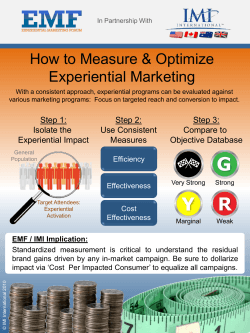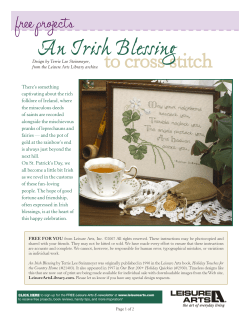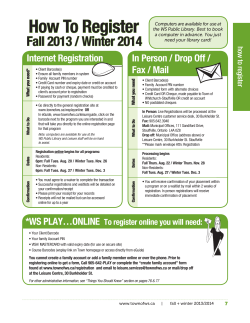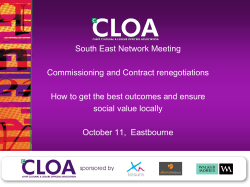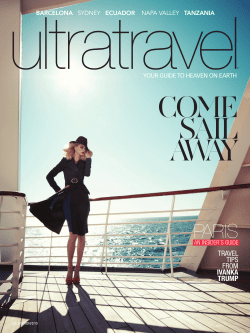
How to Portrait Event Experience: A Special Event as
How to Portrait Event Experience: A Special Event as Experiential Marketing Tool Tuba Sevil Lecturer, Anadolu University, School of Physical Education and Sports, Iki Eylul Campus, (26470), Eskisehir / Turkey Muge Akyildiz Research Assistant, Anadolu University, School of Physical Education and Sports, Iki Eylul Campus, (26470), Eskisehir / Turkey Metin Argan Associate Professor, Anadolu University, School of Physical Education and Sports, Iki Eylul Campus, (26470), Eskisehir / Turkey Mehpare Tokay Argan Assistant Professor, Bilecik University, Bozuyuk Vocational School, Bozuyuk-Bilecik / Turkey 1 How to Portrait Event Experience: A Special Event as Experiential Marketing Tool Tuba Sevil Lecturer School of Physical Education and Sports, Anadolu University Muge Akyildiz Research Assistant School of Physical Education and Sports, Anadolu University Metin Argan Associate Professor School of Physical Education and Sports, Anadolu University Mehpare Tokay Argan Assistant Professor Bozuyuk Vocational School, Bilecik University ABSTRACT The rise of experiential marketing during last decade shed some light on marketing literature. Nowadays, consumers are in search of experiences that “dazzle their senses”, “touch their hearts” and “stimulate their minds” and also marketers need to understand customer experience (Schmitt, 1999). Therefore, studies and researches on experiential features of products or services have appeared in the marketing literature. However, academic investigations on the measurement of event experiences are very limited. Thus, main aim of this study was to identify the underlying aspects of event experience and to examine events as an experiential marketing tool via a sample of 300 respondents who were participated in Kite Festival, an annual event held in Eskisehir. Results revealed three aspects, which are “emotional experience”, “escapist and relaxing experience” and “social and nostalgic experience”. The study has significant implications as to how well marketing practitioners and recreationist implement experiential marketing and experiential dimensions of the events. Keywords: Event, marketing, experiential marketing, event management INTRODUCTION AND LITERATURE The rise of experiential marketing during last decade (Pine and Gilmore, 1999; Schmitt, 1999, 2003) has turned the understanding of consumption experiences into a hot topic for market researchers (Caru and Cova, 2008). Experiential marketing has become a cornerstone of many recent advances in areas such as retailing, branding and events marketing, and it is crossing over to the service sector, from hotels to restaurants to airlines (Smith and Wheeler, 2002) with enthusiasts reported in all sectors of the global economy from consumer products to health care providers (Williams, 2006). Therefore, understanding consumption experience has become a prime goal of today’s marketers, especially with the rise of experiential marketing approaches (Caru and Cova, 2008) that seek to capture customers’ whole minds, to evoke positive emotions and to render them captivated (Shaw, 2005). 2 In this fast growing experience economy, consumers’ desires and needs have also changed, they look for affective memories which combine to create a holistic and long-lasting personal experience (Hosany and Witham, 2009) that enable them to realize their dreams and achieve their desired lifestyle (Smith and Wheeler, 2002). Therefore, nowadays, traditional marketing approaches that view customers as rational decision makers and focus on functional product attributes, benefits of products and quality are inadequate (Hosany and Witham, 2009). Instead, consumers are less interested in maximizing their benefits and functional features (Caru and Cova, 2008), they are in search of experiences that dazzle their senses’, engage them personally, touch their hearts, and stimulate their minds (Schmitt, 1999; Hosany and Witham, 2009). These experiences are achieved through experience providers applying to experiential marketing. Because, experiential marketing approaches view consumers as emotional beings and focuses on achieving pleasurable experiences (Williams, 2006). The emergence of the experience economy has spawned a plethora of studies dedicated to the understanding of consumer experience (Hosany and Witham, 2009). More recently, developments and applications have surfaced in leisure research (Yoshioka, Nilson and Simpson, 2002; Madrigal, 2003; Sumino and Harada; 2004; Barnett; 2005; Tsaur, Chiu and Wang, 2006; Maccarthy, O’Neill and Williams, 2006; Breejen, 2007; Kao, Huang and Wu, 2008). Still, with few exceptions, academic research on the conceptualization and measurement of leisure experiences of the specific events remains sparse. The observance of and participation in festivals or broadly term celebratory events, is an increasingly significant aspect of customer experience. Because, participants of the events seek an enjoyable and memorable experiences through social interactions and performances as they find themselves in a different space and time (Picard and Robinson, 2006). However, leisure marketing literature provides very little guidance on event experience and how event marketers and managers could increase their customers’ satisfaction with an experiential event. In this sense, the purpose of this study was to examine the experiences of participants of Kite Festival which was chosen as a research field. The Kite Festival is an annual event celebrating the coming of the spring, held in Eskisehir, a western city in Turkey. This event is organized by Anadolu University-Physical Education and Sport Faculty. It is an enjoyable event of children, families or students who from morning to late evening gather together to celebrate the coming of the spring through flying a kite to the sky and through the performance of traditional dances and songs. It is a unique event among others and it is a celebration on a regional scale attracting participants of all ages. The festival ground is large enough to support a stage for concerts and shows, food areas and several sponsor attractions. During the two-day, open-air festival provides a massive platform to gather some music groups and their fans, and food court, kite service, kite flying area, drink and food stands are also set up on the festival grounds. METHOD Research and Questionnaire Design The questionnaire of this study included three parts. In the first part of the questionnaire, event experiences of the participants were measured. Because there are not much studies or approach to measure and analyze event experience in the literature, this led researchers to develop a new survey questionnaire in order to examine event experience aspects of the participants of Kite Festival. In developing survey questionnaire, items that consisted of the domain of leisure experiences emerging during the festival were adapted from a certain number of studies. Bent Richard’ (2005) study on experiences of volunteers with a multi-sport 3 special event and Sumino and Harada’s (2004) study on affective experience at the stadium and intention to attend an event were among these studies. Also, Pine and Gilmore’s book on the Experience Economy (1999) and Schmitt’s book titled as Customer Experience Management were thoroughly scrutinized before preparation of the survey. In order to develop questions regarding leisure experience evolved in the events as a leisure activity, items were adapted from Borrie (1995); Chao (2003); Cotte (1998); Kao, Huang and Wu (2008); Manfredo and Driver (1996) and Tsaur, Chiu and Wang (2006) with some modifications and wording revisions to fit our empirical case. Each item was measured on a 5-point Likert scale, “5 = strongly agree” to “1 = strongly disagree”. The second part of the questionnaire included attendance patterns and behavioral tendencies of the respondents who participated in the Kite Festival. The respondents were also asked to indicate their gender, age, education status, occupation, income status and marital status at the last part of the questionnaire. The questionnaire was pre-tested on a group of 47 dance festival participants who were judged to be representative of the target population. After some procedures of exploratory factor analysis, a scale of 16 items was proposed. Sample The sample is comprised of people participating in the Kite Festival 2009. The data were collected during the Festival day. The questionnaires were answered by respondents in the researchers’ presence. For groups of respondents who needed further explanations in filling out the questionnaires, the researcher helped the respondents to fill out the questionnaire. A total of 350 questionnaires were distributed, 300 of which were completely answered, resulting in a return rate of 85.7 percent. RESULTS Characteristics of Sample A total of 300 questionnaires were achieved after the effort of data collection. Gender of the respondents was almost evenly distributed with 49.7 per cent male and 50.3 per cent female and most of the respondents were single (%60); %39 of the participants were within 21-30 age brackets and %51.3 of the participants were students. The majority of the respondents (%34.7) reported a monthly household income of $330 and below. Respondents who are bachelor degree occupy half of the sample (%53.3) (see Table 1). Attendance Patterns of the Participants Participants were asked about their attendance patterns to the Kite Festival. Of the sample, %39 of the respondents reported that they participated in Festival with their families and %37 of them with their friends. Whereas 61.3% of respondents were first-time participants to Kite Festival, 21% of the respondents participated for the second time and %17.7 of them participated three times or more. Moreover, brochure, advertisement and catalogue were reported as the most benefitted source of information about the festival (%39.3), it was followed by friends’ recommendation (%38.3) and written and visual media (%22.3) (see Table 2). 4 Table 1. Demographic Information Regarding Participants’ Characteristics Frequency % Gender Female Male 151 149 50.3 49.7 Occupation Student Public Official Laborer Self employed Out of employ Faculty Member Retired Tradesman 154 38 33 20 15 15 13 12 51.3 12.7 11.0 6.7 5.0 5.0 4.3 4.0 31 66 160 42 10.7 22.0 53.3 14.0 Education Level Primary School Secondary School Bachelor Degree Post Graduate n=300 Frequency % Age 20 and < 21-30 31-40 41 and > 73 117 68 42 24.3 39.0 22.7 14.0 Marital Status Single Married 180 120 60.0 40.0 Income Status 330 USD and < 331-661 USD 662-991 USD 992-1322 USD 1323 USD and > 104 75 43 36 42 34.7 25.0 14.3 12.0 14.0 Table 2. Information Regarding Attendance Patterns of the Participants Attendance patterns On my own With an organized group With my friends With my family Attendance frequency First participation Second participation Third participation or more Source of information Written and visual media (newspaper, radio, TV, internet) Friends’ recommendation Brochure, advertisement or catalogue Frequency % 36 36 111 117 12.0 12.0 37.0 39.0 185 63 53 61.3 21.0 17.7 67 115 118 22.3 38.3 39.3 Event Experience Dimensions There was a total of 16 scale items that could influence or determine dimensions related to event experiences; thus principal component factor analysis was used to sort out and classify these variables as well as to convert them into main factors. To apply factor analysis on items underlying the experiences of participants, it is necessary to test the Kaiser-Meyer Olkin (KMO) measure of sampling adequacy (Odabasi and Argan, 2009; Zhang et al., 2003). For the experience variables, Kaiser-Meyer Olkin (KMO) was 0.891 indicating that the sample was adequate for factor analysis (Odabasi and Argan, 2009; Kaiser, 1974). The Bartlett Test for Sphericity (BTS) was 1.669 (p<0.001), indicating that the hypothesis variance and covariance matrix of variables as an identity matrix were rejected; therefore, factor analysis was appropriate. According to principal axis analysis, three factors had an eigenvalue greater than 1.0, explaining a total of 54.555 percent of the variance. The findings indicate the emergence of 5 three factors regarding to event experience. These factors were labeled as “emotional experiences”, “escapist and relaxing experiences” and “social and nostalgic experiences”. In the factor analysis, the percentage of the variance explained by each factor indicates the relative significance of the factors. Accordingly, the first factor, labeled emotional experiences, explained a large part (% 38.582) of the total variance, having a greater significance than the other two factors. The items of emotional experiences factor were related to the participants’ inner feelings, emotions and thoughts that engage participants emotionally and creatively. This factor contained seven items. The second factor, labeled escapist and relaxing experiences explained 8.394 percent of the variance. Escapist and relaxing experiences factor contained five items, all relating to physically and mentally relaxation, getting away with the monotony of life and escaping from boredom. It showed high loadings for the items. Lastly, the third factor, labeled social and nostalgic experiences, explained 7.579 percent of the variance. The items of this factor were related to meeting and communicating new people, past memories and nostalgia. This factor consisted of four items. All three constructs met the criterion that a factor loading should be equal to or greater than 0.48. The Cronbach alphas were equal to or greater than 0.70 and the total of scale reliability was 0.89. Factors, [emotional experiences (0.81), escapist and relaxing experiences (0.80), social and nostalgic experiences (0.70)] had higher scores than the recommended level of 0.70 (Kim et al., 2003; Nunnally, 1978; Odabasi and Argan, 2009) (see Table 3). Table 3. Factors and Items on Event Experience Factors Factor Loadings (β β) Mean S.D. .629 .833 .514 .538 .541 .585 .677 4.43 4.32 4.31 4.29 4.26 4.17 4.11 0.78 0.83 0.83 0.76 0.85 0.89 0.93 .758 .594 4.51 4.46 0.79 0.76 .777 .653 .602 4.41 4.40 4.25 0.81 0.78 0.88 .734 .515 .483 .764 4.32 4.30 4.15 4.14 0.84 0.92 1.03 0.99 Factor 1: Emotional Experience It made me feel free. It developed a sense of ability and skill. It helped to get an exciting experience. It gave a sense of achievement. It helped to get a sense of self-confidence. It developed a creative imagination. It provided to get an exploration experience. Factor 2: Escapist and Relaxing Experience It allowed getting away from stress of daily life. It allowed getting away from boredom. It allowed to get away from monotony and allowed me to enjoy life. It provided mental relaxation. It provided physical relaxation. Factor 3: Social and Nostalgic Experience It provided an opportunity to communicate with people having same interest. It made me lose track of time. It reminded me past memories. It provided an opportunity to meet new people. Cumulative % of variance Internal consistency of the scale (16 items) S.D. Standard Deviation 1= strongly disagree 5=strongly agree Eigenvalues (% of variance) Alpha (α) 6.173 (38.582) .81 1.343 (8.394) .80 1.213 (7.579) .70 54.555 .89 6 DISCUSSION AND CONCLUSION This paper shows how important it is to pay attention to new arising tendencies in leisure towards customers’ experiences and identifies how to plan leisure events to create holistic experiences as part of an effective marketing strategy. The main objectives of this study were i) to identify the underlying aspects of event experience of the leisure participants and ii) to investigate the attendance patterns and demographic characteristics of participants. Overall, our findings advance our understanding of the experience economy concepts in event marketing and leads to a new source of knowledge to measure event experience. This study developed a 16-item survey instrument to evaluate dimensions related to event experience. The scale exhibited ideal internal consistency and met rigorous conceptual and empirical criteria for validity. The results indicated that event participants’ experiences can be conceptualized and represented in terms of three dimensions. Data analyses showed that the three realms of experience demonstrate adequate reliability and validity. Dimensions related to event experience comprise “emotional experience”, “escapist and relaxing experience” and “social and nostalgic experience”. These aspects could demonstrate that events are not only at the heart of the entertainment but also have many experiential dimensions. Therefore, this means that event experiences do not rely exclusively on entertainment; entertainment is only one part of an event experience. Rather, this study indicated that event experience can build escapist and relaxing, social and nostalgic and even emotional experiences by providing participants to be free with the kites in the air rather than playing the passive role which involve much greater immersion than entertainment experiences (Pine and Gilmore, 1999). Moreover, findings of this research indicate that to some extent, results may allow managers to have a better understanding of the importance of the experiential features of the events and how well they implement experiential marketing. Furthermore, they would have more specific ideas about how to design and plan their leisure events with “experience” concept to improve their success. In this regard, these results may enable organizers or managers to design appropriate marketing and promotional strategies with distinctive brand position to differentiate themselves from competitors. Overall, the results of the current study are of interest to marketers and practitioners. In general, the information obtained, while preliminary, can be considered as a first attempt in terms of evaluation of event experience dimensions employed consciously in Turkey. The study further provides some useful insights for managerial applications. First, marketers can apply their marketing-mix decisions according to these findings. Second, event organizers can use experiential qualities and they can provide to create holistic experiences for leisure participants. LIMITATIONS AND RECOMMENDATIONS FOR FURTHER RESEARCH As with all research, this study is not free of some limitations, and it suggests avenues for future research consideration. The current study focused specifically on a limited number of people. Future research on event experience could be extended to include a wider demographic base, both geographically and internationally, to further explore the extent to which the findings are generalizable. The respondents in the study were limited to those who live in Eskisehir - a single Turkish city. Furthermore, the focus on Turkish people places the research in a particular cultural context. Consequently, the results may not adequately represent the total population in Turkey. Although the sample was appropriate for a survey on event experience, the results may differ if other people participating in different events are studied. In future studies, many 7 events or festivals providing leisure opportunities should be examined to compare consumers’ experiences in leisure. Further researches may apply our conceptual framework to major or hallmark events, such as Rio Carnival, Olympics, some sport championships etc., in which experience plays a crucial role for customers’ or participants’ future intentions and satisfaction to examine whether this consequence varies according to scope or size of the events. This effort would provide a great helpful insight to clarify experiential features of different events. The next interesting area that should be investigated is the dimensions of event experience in different countries. Different countries have different cultural and social implications and different habits regarding leisure events. Therefore, a different assortment of experience aspects can provide interesting results and new insights into event experience, which should be studied in future research. A future study that compares different samples of countries with special traditional events can shed light on this issue. REFERENCES Barnett, L.A. (2005). Measuring the ABCs of Leisure Experience: Awareness, Boredom, Challenge, Distress, Leisure Sciences, 27, 131-155. Borrie, W.T. (1995). Measuring the Multiple, Deep and Unfolding Aspects of the Wilderness Experience Using the Experience Sampling Method, Faculty of the Virginia Polytechnic Institute and State University, Doct. Thesis, Blacksburg, Virginia. Bent Richard, J.M. (2005). The Experience of Executive Level Special Event Volunteers, Arts in Sport and Recreation Administration, Master Thesisi University of New Brunswick, Canada. Breejen, L. (2007). The Experiences of Long Distance Walking: A Case Study of the West Highland Way in Scotland, Tourism Management, 28, 1417-1427. Caru, A., Cova, B. (2008). Small versus Big Stories in Framing Consumption Experiences, Qualitative Market Research: An International Journal, 11(2), 166-176. Chao, C. (2003). Off-site Benefits of Recreation to Participants’: An Assessment of Psychophysiological Effects, Doctorate Thesis, Clemson University. Cotte, J.S. (1998). Deciding What to do: A Behavioral Framework for Leisure Consumption Decisions, Doctorate Thesis, University of Connecticut. Hosany, S., Witham, M. (2009). Dimensions of Cruisers’ Experiences, Satisfaction and Intention to Recommend, Journal of Travel Research, 49(3): 351-364. Kaiser, H. F. (1974). An Index of Factorial Simplicity, Psychometrics, 39, 31-36 Kao, Y., Huang, L., Wu, C. (2008) Effects of Theatrical Elements on Experiential Quality and Loyalty Intentions for Theme Parks, Asia Pacific Journal of Tourism Research, 13(2), 163-174. Kim, S.S., Lee, C.K., Klenosky, D.B. (2003). The Influence Push and Pull Factors at Korean National Parks, Tourism Management, New York USA, 24, 169-180 in Odabasi, Y., Argan, M. (2009). Aspects of Underlying Ramadan Consumption Patterns in Turkey, Journal of International Consumer Marketing, 21, 203-218. Manfredo, M.J., Driver, B.L., Tarrant, M.A. (1996). Measuring Leisure Motivation: A MetaAnalysis of the Recreation Experience Preference Scales, Journal of Leisure Research, 28(3), 188-213. Maccarthy, M., O’Neill, M., Williams, P. (2006). Customer Satisfaction and Scuba-Diving: Some Insights from the Deep, The Service Industries Journal, 26(5), 537-555. Madrigal, R., (2003). Investigating an Evolving Leisure Experience: Antecedents and Consequences of Spectator Affect During A Live Sporting Event, Journal of Leisure Research, 35(1), 23-48. Nunnally, J.C. (1978). Psychometric theory, 2nd ed., New York: McGraw-Hall. 8 Odabasi, Y., Argan, M. (2009). Aspects of Underlying Ramadan Consumption Patterns in Turkey, Journal of International Consumer Marketing, 21, 203-218. Picard, D., Robinson, M. (2006). Festivals, Tourism and Social Change, Remarking Worlds, Channel View Publications, England. Pine, B.J., Gilmore, J.H. (1999).The Experience Economy: Work is Theatre & Every Business A Stage: Goods & Services Are No Longer Enough, Harvard Business School Press, USA. Schmitt, B. (1999). Experiential Marketing; How to Get Customers to Sense, Feel, Think, Act and Relate to Your Company and Brands, Free Press, New York, USA. Schmitt, B. (2003). Customer Experience Management: A Revolutionary Approach to Connecting with Your Customer, Wiley and Sons, New Jersey. Shaw, C. (2005). Revolutionize Your Customer Experience, Houndmills, Palgrave Macmillan, Great Britain. Smith, S., Wheeler, J. (2002). Managing the Customer Experience: Turning Customer into Advocates, Prentice Hall, Great Britain. Sumino, M., Harada, M. (2004). Affective Experience of J. League Fans: The Relationship between Affective Experience, Team Loyalty and Intention to Attend, Managing Leisure, 9, 181-192, October. Tsaur, S.H., Chiu, Y.T., Wang, C. H. (2006). The Visitors Behavioral Consequences of Experiential Marketing; An Empirical Study on Taipei Zoo, Journal of Travel and Tourism Marketing, 21 (1), 47-64. Williams, A. (2006). Tourism and Hospitality Marketing: Fantasy, Feeling and Fun, International Journal of Contemporary Hospitality Management, 18(6), 482-49. Yoshioka, C.F., Nilson, R., Simpson, S. (2002). A Cross-Cultural Study of Desired Psychological Benefits to Leisure of American, Canadian, Japanese and Taiwanese College Students, LARNet - The Cyber Journal of Applied Leisure and Recreation Research, February, 1-10, available at http://larnet.org/2002-4.html. Zhang, J.J., Pennington-Gray, L., Connaughton, D.P., Braunstein, J.R., Ellis, M.H., Lam, E.T.C. (2003). Understanding Women’s Professional Football Game Spectators: Sociodemographics, Game Consumption, and Entertainment Options, Sport Marketing Quarterly, 12(4), 228-243. 9
© Copyright 2025
